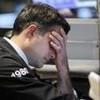Bear market fall batters industries
Bloomberg

refid:10416618 ilişkili resim dosyası
The worst annual decline in the Standard & Poor’s 500 Index has dragged down every industry in the benchmark gauge and 97 percent of its stocks.
All 64 of the S&P 500’s so-called level-three categories, groups such as "distributors" and "leisure equipment" with as few as one company, dropped in 2008. Among 500 stocks, 483 slipped as the index fell 49 percent, poised for the biggest yearly retreat ever.
"There seems to be no bottom," Laszlo Birinyi, who oversees more than $350 million as president of Birinyi Associates, said on Bloomberg Television. "We have no tools that tell us where to go now."
More stocks decreased in the current bear market than in the 49 percent rout after the technology bubble burst in 2000. The breadth of declines this year is leaving investors without defensive strategies to protect against losses that erased more than $8 trillion from U.S. equities in 2008.
The 2000-2002 retreat
During the S&P 500’s retreat between March 2000 and October 2002, nine industries climbed, including two - tobacco and healthcare - that rose more than 80 percent. Since the S&P 500 peaked in October 2007, seven stocks in the index advanced, according to data compiled by Bloomberg. At least 10 times as many rose in the 2000-2002 sell-off.
UST, the Stamford, Connecticut-based snuff maker being acquired by Altria Group, increased the most since the S&P 500 peaked last October, gaining 40 percent. By comparison, 35 stocks in the S&P 500 doubled during the bear market that began in March 2000.
American International Group posted the year’s biggest tumble in the S&P 500 as losses from mortgage-backed securities forced the government to arrange a bailout of the New York-based insurer. Shares from Bear Stearns Cos. to Lehman Brothers Holdings, once among the biggest New York-based brokerages, disappeared from the market as credit crisis worsened and led to $965 billion in global losses.
The S&P 500 reached an 11-year low yesterday after jobless claims approached the highest level since 1982 and the Federal Reserve said manufacturing in the Philadelphia area shrank. Bank losses shrunk the economy and sent the gauge down 52 percent from its Oct. 9, 2007, record of 1,565.15.
"None of us know at what point we’ve sufficiently priced in all of the negative economic news," said Liz Ann Sonders, chief investment strategist at Charles Schwab & Co., which oversees $1.3 trillion.
Among industries in the S&P 500, biotechnology companies have fallen the least with a 3.6 percent drop. Thirty-two lost more than 50 percent, led by 90 percent decline in thrifts and mortgages.
A year ago, 11 companies in the S&P 500 traded at less than $10 a share. Now, 111 do.
"It’s certainly dysfunctional markets, not tied to anything but the vagaries of emotions," said James Paulsen, who helps oversee about $220 billion as chief investment strategist at Wells Capital Management. "The fundamentals of the world aren’t changing as fast as these prices are."
Financial job losses
Meanwhile, the bloodletting in the financial-services industry will accelerate in coming months, with job cuts doubling to about 350,000 worldwide by mid-2009, said Brian Sullivan, chief executive officer of search firm CTPartners.
Reductions on that scale would be equivalent to 20 percent of the global workforce at financial companies before the credit crisis began, Sullivan, whose firm has worked with Citigroup and JPMorgan Chase, said in an interview. Banks, brokerages and funds have eliminated about 170,000 positions worldwide.
"This is the financial equivalent of World War II," Sullivan said. "It's unprecedented. You're seeing a seismic shift in the population of banking."
Banks are racing to cut jobs from New York to Sydney as frozen credit markets cause revenues to tumble and the financial industry tries to digest almost $1 trillion of writedowns.
